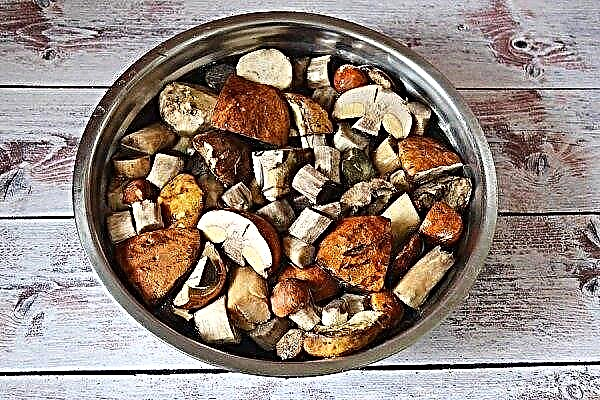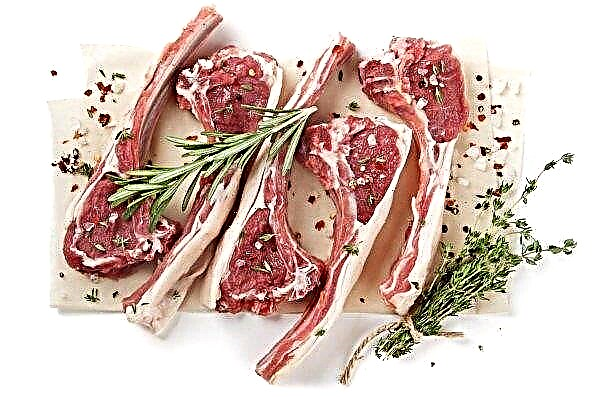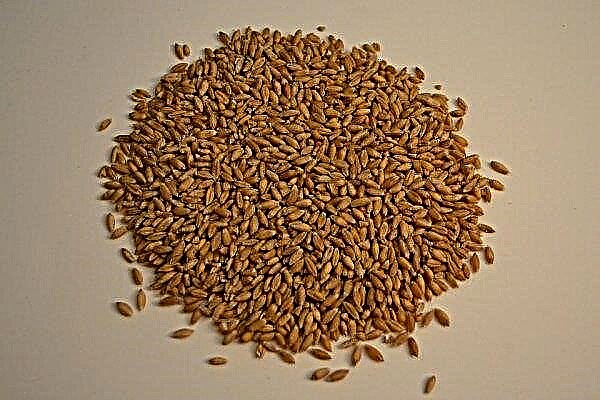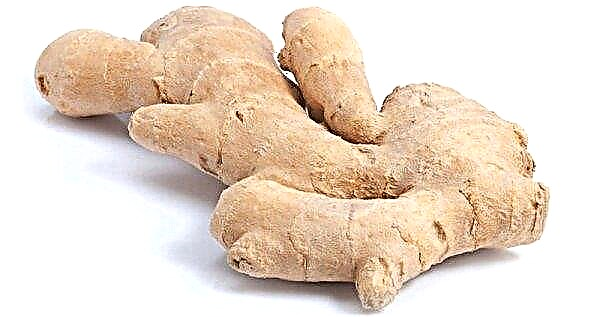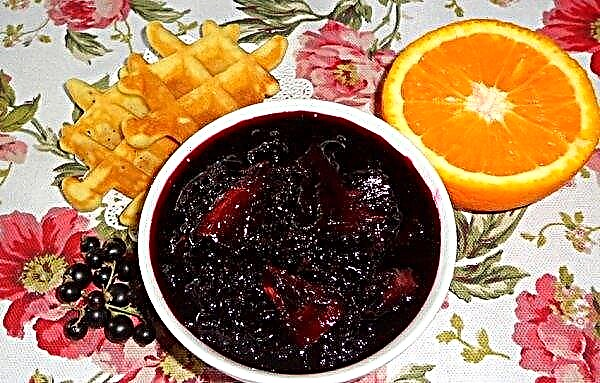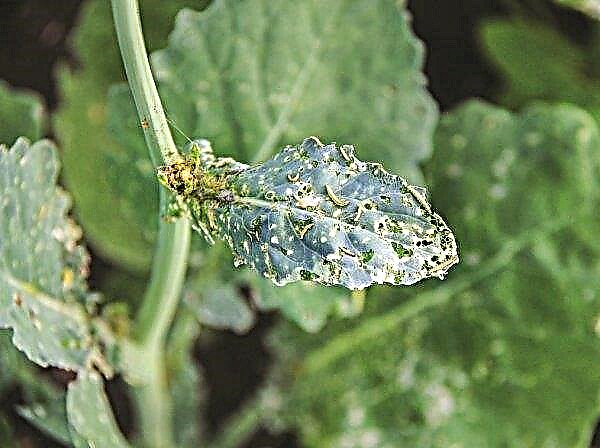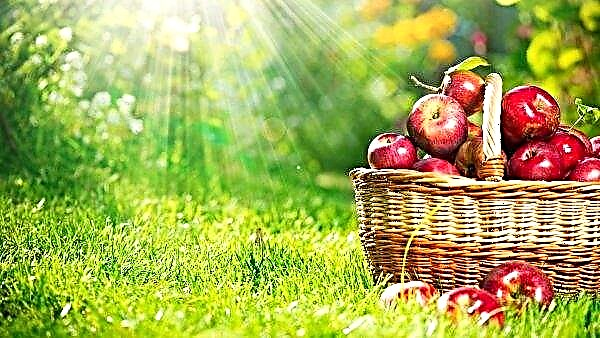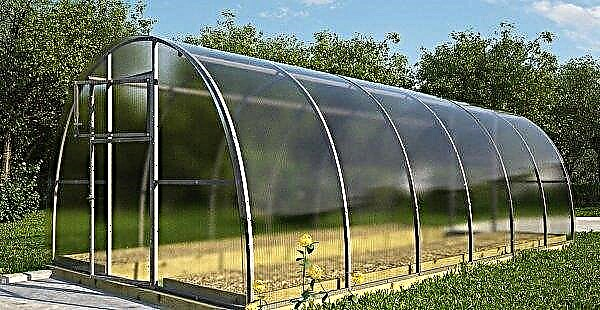Raspberry Hercules is a repairing variety, the peculiarity of which is a double fruiting per season. The description of the plant, as well as the technology of its planting, are described below.
Repairing large-fruited raspberries Hercules
The repairing variety Hercules (Hercules) was bred by a domestic botanist and breeder I.V. Kazakov. The plant was obtained by crossing such varieties as: Ottom Blyz and No. 14-205-4.
The reviews left by gardeners about Hercules raspberries differ, because the taste and external characteristics of the plant may vary depending on the region of growth. Referring to the responses of gardeners growing this variety in the cold northern regions, it can be noted that the plant brings a small and small crop, and freezes in winter.
Did you know? In the course of breeding work in 1896 in Geneva, a variety of purple raspberries was bred. This variety appeared as a result of crossing a red and black plant species.
According to gardeners, growing raspberries in the southern and central regions with a warm and temperate climate will bring a plentiful harvest and will not affect the taste of berries.
Appearance of the bush, size and type of berries, fruiting time
Raspberry Hercules is a repairing variety that brings crops 2 times a season, namely in early July and late August. The fruiting period lasts up to 6 weeks. The raspberry bush is not sprawling, reaches a height of 2 m. Powerful shoots, do not bend under the weight of the fruit. The newly formed stems have a light green color, and those that have reached one year of age acquire a purple hue and become covered with a waxy coating. Leaf plates - dark green, dull, corrugated.
The fruit is large, red in shape resembles a cone. It has a sweet taste, with a touch of sour. The mass of the berry can reach up to 15 g, its average weight is 10 g. Raspberries have a dense, quite juicy structure. From one bush you can collect up to 4 kg of berries.
Video: Repairing raspberries Hercules
Raspberries do not need additional pollination, because bisexual flowers form on flower ovaries. But, if you want to significantly increase harvest, you need to attract pollinating insects to the site. Bees are attracted by brightly colored garden flowers, and it is also possible to set top dressing with raspberry with sweet syrup, which lures insects.
Advantages and disadvantages of the variety
- Among the positive qualities can be identified:
- the bush can be cultivated on any type of soil;
- resistant to drought;
- has immunity to many fungal infections;
- good transportability;
- the berry is not prone to rot on the branches;
- large-fruited crop.
- The disadvantages of raspberries Hercules:
- copious amount of thorns on stems;
- poor winter resistance.
Agricultural technology
To grow strong raspberry bushes, you need to choose the right planting material. Seedlings are best bought at local nurseries. When choosing, pay attention to the appearance of the plant and its rhizome.
High-quality planting material should be:
- without diaper rash and rot;
- with elastic root processes of at least 15 cm;
- on the stem should be 3 kidneys.

Seat selection
For this variety, the choice of the site on the south side of the house is best suited, because it requires abundant lighting. Do not plant bushes under a large tree - this will lead to an invasion of insects and poor lighting of the culture. The area should also be protected from draft, so raspberries are placed near the hedge or near the outbuildings.
Humidity in the area should be moderate, the occurrence of groundwater at least 1.5 m in depth.
 A feature of the variety is the possibility of growth on any type of soil, but it is best to choose loamy or sandy loam soils for cultivation
A feature of the variety is the possibility of growth on any type of soil, but it is best to choose loamy or sandy loam soils for cultivation
Landing and care
Landing can be done both in spring and autumn. Spring planting is carried out during the thaw in about mid-April, when the air temperature warms up to + 15 ° C, and in autumn, you can plant a crop in the period from mid-September to mid-October.
6 months before the procedure, you need to prepare the site. It is freed from vegetable debris and dug with fertilizer: 10 kg of humus, 30 potassium, 50 g of superphosphate, taking into account 1 m². After feeding, the area is leveled.
Step-by-step instructions for landing:
- Dig a hole measuring 50 cm deep and 60 wide.
- Mix the dug up earth with 10 kg of sand and 10 kg of humus.
- At the bottom of the hole, fill up the drainage base, in the form of sea pebbles.
- After pouring the resulting soil substrate to the middle of the pit.
- Carefully insert the seedling, and level the roots on the embankment.
- Pour the soil to the top of the hole and compact it tightly.
- Pour a seedling of 5 liters of water.

Watering is usually carried out as the earthen coma dries up, as well as taking into account the harvest. It is necessary to bring in liquid 1-2 times a week for 5 l under each bush.
Important! Do not water the plant 2 days before the berries are fully ripe, because this will lead to a distortion of taste.
Raspberry care also consists in timely top dressing, which is carried out 3 times a season:
- First - takes place at the end of May and consists of: 2 kg g of manure and 10 l of water. This solution is enough for one bush.
- Second fertilizer held during the period of July fruiting. It is necessary to spray from: 30 g of superphosphate and 30 g of urea per 10 l of water.
- Third feeding held in late August, when the second fruiting begins. For digging make 50 g of superphosphate per 1 m².

Pest and Disease Control
Hercules is resistant to many diseases and pests, but if the plant's immunity is weakened, it pests such as aphids and raspberry mites can attack.
Aphid It is a small insect that has a green color and a body length of only 4 mm. The pest feeds on the sap of the plant and leads to a slow withering of leaves and stems. You can notice the insect on the bush by the presence of twisted leaf plates in a sticky coating.

Fighting aphids:
- Manual cleaning of damaged parts of the plant.
- Irrigation with a soapy solution, which is prepared from 250 g of dust soap and 10 l of warm water. Spraying is carried out for 3 days in the morning.
- The use of the drug "Karbofos" - 5 ml per 10 liters of water.
Raspberry tick - a microscopic insect reaching a length of 0.4 mm. The pest hibernates in fallen leaves and debris on the site, and with the advent of spring, females begin to actively lay offspring that feeds on the juice of the bush, which leads to its withering. You can notice the presence of a tick on the culture by the presence of small cobwebs on the leaf plates.

Tick control:
- Timely cleaning of the site.
- Digging the soil near the bush.
- Irrigation with a soap-ash solution, which is prepared from 100 g of liquid soap, 300 g of ash and 10 l of water.
If the bush does not receive proper care or is grown in very humid conditions, then there is a high risk of infection with diseases such as anthracnose and purple spotting.
Did you know? The first raspberry garden in Russia was founded by order of Yuri Dolgoruky. The raspberry was so large that even bears were found there.
Spotting occurs due to increased humidity. Fungal spores settle on leaf blades, causing the appearance of brown spots with a diameter of 3-4 mm, which eventually dry out and dry out, leaving voids. The plant slows down all vital processes.
Fighting Purple Spotting:
- Timely pruning of the plant.
- Removal of damaged leaf blades and their further burning.
- Irrigation of 1% copper sulfate (100 g per 10 liters of water).

Anthracnose is one of the varieties of fungal infections that affects the plant. White spots with a bright red border may appear throughout the culture. Black spots may appear on shoots and lignified areas. Over time, the immunity of the culture will weaken, it will become less resistant to cold and die.
The disease is treated by spraying with Bordeaux liquid (300 g per 10 l of water), which is carried out during the period of budding. After irrigation is carried out 2 more times with an interval of 10 days.

Trellis
If desired, the gardener can install trellises next to the raspberry bushes, which will not only support the plants, but also facilitate the task of picking berries. Along the perimeter of each row of raspberries, it is necessary to drive in wooden stakes 2 meters high and 1.5 m apart. 2 m high and about 1.75 m, you need to attach 2 wires on which the branches of the bushes will be tied.

Pruning and wintering
In autumn, stalks are trimmed. It is necessary to cut all 2-year-old shoots into a ring, i.e. completely get rid of them. Trim the rest by 20 cm. Before winter, you should also carry out sanitary pruning, which consists in completely getting rid of dry branches damaged by diseases.

For the winter period, the site must be freed from weed grass and collect all fallen leaves.
Important! If in summer raspberries were mulched, then it is necessary to remove the top layer of earth near the stem of the plant so that field mice do not wound in it.
To preserve the bushes during the cold season, they are pressed to the ground or a greenhouse shelter is built for them.

Harvesting and transportation
Harvesting is best in dry, calm weather. The berries are placed in wicker baskets, the bottom of which is lined with paper. It is necessary to preserve the fruits in the refrigerator at a temperature from 0 ° C to + 4 ° C, air humidity should be 70%. Observing these conditions, berries can maintain commercial quality for 5 days.
Choosing a cultivator of Heracles for repair, the gardener is guaranteed to get a stable crop 2 times a season. Large-fruited raspberries are perfect for growing in areas with a warm and temperate climate, it is not only high-yielding, but also has immunity to many diseases.
Network user reviews
Heracles planted 2 years ago, in the autumn we constantly cut to 0-year-old fruiting I don’t like to collect, in July and before frosts, but when the heat, watering is desirable, since the berry is greatly reduced, my mother says, “raspberry for diabetics, so it’s not sweet , I send most of the harvest to wine.



